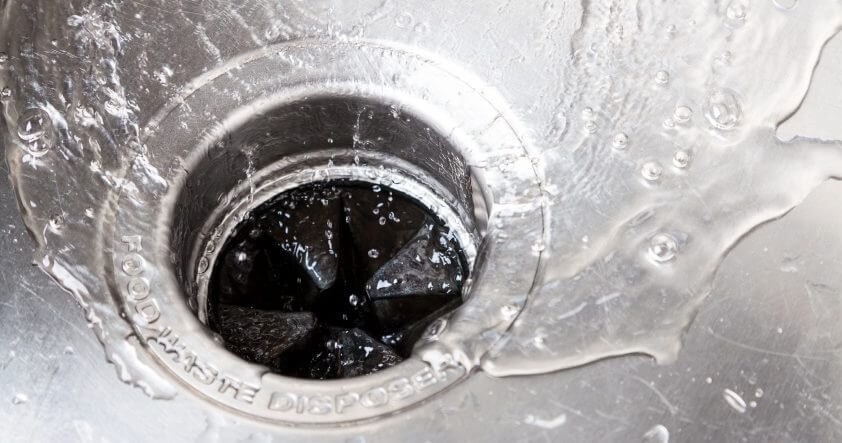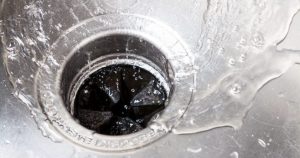Fixing a Garbage Disposal
If your garbage disposal is jammed or leaking there could be a few things going on, so keep reading for helpful tips on troubleshooting and fixing it.
It can seem intimidating to try to fix a garbage disposal by yourself, but it really isn’t that bad. To help you feel more confident, here’s a quick lesson in how garbage disposals work:
There’s a shredder inside your garbage disposal that breaks down food and other scraps until they’re small enough to go down the drain. Then an impeller arm and plate collect all the broken down materials and force them out the drain.
It’s a fairly simple device that often just takes some basic troubleshooting to fix. Here’s how.
Signs of a garbage disposal not working:
- You turn it on, but it does nothing. There’s no humming sound or anything.
- The motor hums but doesn’t grind any food
- There’s a loud clanging sound
Let’s tackle those one at a time.
If you turn the machine on and it does nothing, it’s likely it’s not receiving power. Find the reset button on the bottom of the machine and press it. Most of the time that’s all you have to do to get it working again.
If that doesn’t fix the problem, there could be a problem with the outlet it’s plugged into. Go ahead and unplug your garbage disposal and plug something else in to test it. If it seems to be the outlet, you’ll want to check the breaker circuit. It should be the same one the dishwasher is plugged into. Switch it off and on again and that should reset everything and make your garbage disposal work again.
If the motor hums but isn’t grinding anything, it’s probably jammed. Don’t continue to run the machine as this could break one of the grinder blades. Most of the time there’s a bone, fruit pit, or something else in there jamming it up.
Unplug the machine and find the hex wrench that came with your disposal. If you didn’t move it, it should be taped to the disposal. Fit it into the hex hole on the bottom of the machine and turn it back and forth several times. This will loosen the impeller and help everything start to move again.
If your machine didn’t come with a hex hole, you can use a wooden spoon to accomplish the same thing. With the power disconnected, stick the end of the spoon into the machine through your sink, push it down onto one of the blades, and try to rotate the impeller back and forth.
That should force free whatever was jamming it in the first place and you can use tongs or a fork to fish it out. Don’t ever stick your hand in the disposal!
If there’s a loud clanging sound, your garbage disposal is about to be jammed. Disconnect the power, grab your flashlight, and try to figure out what it is. Once you’ve found the foreign object, carefully reach in with your tongs again to grab it out.
Want More Tips Like This? Have Them Delivered To Your Inbox.
Sign up for the Plumb Smart Newsletter for my best tips and tricks to make your plumbing last longer.
Garbage Disposal Best Practices
Keep Your Garbage Disposal Clean
Once a month, dump in a stale tray of ice cubes and turn on your machine. This will keep the inside nice and clean.
For a fresh scent, toss in your lemon or lime peels after using the juice in your recipes. Keep the water running 10-15 seconds after turning your disposal off to make sure everything gets rinsed out. This not only ensures that all the wastes goes completely out of the drain, but it also cleans any salts out, protecting from corrosion.
Other Disposal Tips:
- Never stick your hand in it – always use tongs or some other utensil
- Always run the water when you use it, and preferably cold water
- Use it frequently. Infrequent use can cause the blades to rust.
- After washing dishes, drop a quarter of a lemon and turn on the disposal (with the water running!). This produces a nice and clean scent for your clean kitchen.
- Always think about what you’re putting into the disposal. If it’s large or there’s a lot of it, you might want to just dump it in the trash. Remember, not everything should go in your disposal just because you have one.
Things to Never Put in Your Disposal
- Glass, bones, plastic, metal, or paper
- Grease or cooking/animal fat – these can solidify and clog your drains.
- Fibrous foods like corn husks or celery stalks – they will jam the disposal
- Flour, cornmeal, or other powdery substances – these produce pastes that stick to the sides of the disposal and pipes.
- Coffee grounds – they accumulate in the drains and can cause the pipes to clog
- Starchy food like potatoes – the starch turns into a thick paste and make the blades stick
Follow these tips to fix your garbage disposal when it’s not working and teach the others in your household to follow these best practices and you should be problem-free!
Schedule a Plumber
Schedule a plumber if you need assistance, we are happy to help.
Read our reviews to learn more about us or our services.

